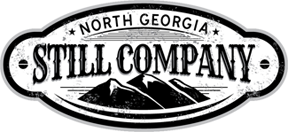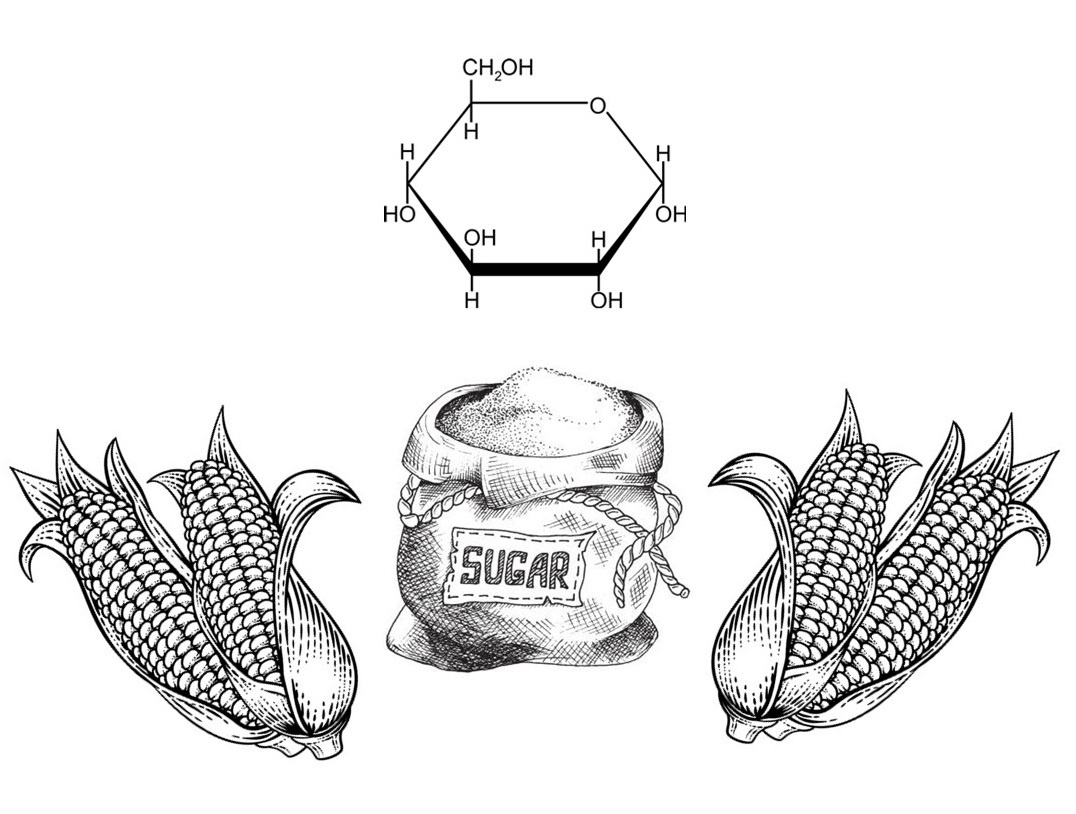Dextrose: Could it be all-grain?
What is dextrose? Dextrose is a type of simple sugar that’s stored as starch. Chemically, dextrose is identical to glucose. The term dextrose is used when glucose is derived from starch. 1
Did you catch that? Sugar derived as starch. The same sugars we are extracting from our grains through enzymatic action, via the addition of malt or pre-packaged amylase enzymes after gelatinizing.
With that said, why is it distiller “taboo” to bump your grain mashes with dextrose and call it all grain?
First, let’s dive into the differences between this and other sugars.
“Sugar” is normally a general term referring to different sugars including monosaccharides, disaccharides, and polysaccharides.
Monosaccharides are the simplest forms of sugar, such as glucose (dextrose), galactose, and fructose. Disaccharides are sugars containing two molecules with examples such as maltose, lactose, and sucrose. Finally, polysaccharides consist of three or more sugar molecules such as cellulose, glycogen, and starch.2
Monosaccharides are of course the easiest sugar molecule for yeast to consume. The sugar is in its simplest form and therefore is easily consumed by the yeast. Since Dextrose is considered a mono, this makes it the most sought-after sugar in the brewing/distilling community due to its ease of fermentation.
Now let’s get back to the original question.
Why, if dextrose is simple sugars derived from starch (with corn starch being the predominant source in the US), is it not considered all grain?
Browsing multiple forums for other thoughts on this question, I came across some rather interesting responses. These responses ranged from taste, cost, waste of the sugar if grains are available, tradition; even nothing more than bragging rights for the moonshiner who does it the “hard way.”
I then wondered if this was a direct result of Alcohol and Tobacco Tax and Trade Bureau (TTB) regulations or standards that have found their way into the home distilling/moonshining community, so off to the search engines I went again.
Chapter 4 of the TTB Spirit Class and Type Designation document 2007 lists the following:3
WHISKY – Spirits distilled from a fermented mash of grain at less than 95% alcohol by volume (190 proof) having the taste, aroma and characteristics generally attributed to whisky and bottled at not less than 40% alcohol by volume (80 proof).
For you bourbon lovers:
BOURBON WHISKY – Whisky produced in the US not exceeding 80% alcohol by volume (160 proof) from a fermented mash of not less than 51% corn and stored at not more than 62.5% alcohol by volume (125 proof) in charred new oak containers.
I highly recommend you check out the document referenced for more information; as it continues through each type of whisky from straight bourbons, wheat, rye, etc. listing the specifications of each. Also listing other standards of blending, coloring, etc., which we touched on in the Additives episode of UN-TAXED Podcast if you are a viewer/listener.
Guess what the one thing I didn’t find is? A specific reference to grain byproducts, only that it had to be fermented from a mash of grain.
Now before anyone says it – I know you’re thinking it. There is of course an argument to be had with that word mash. Mash, we all know, is defined as a mixture of cereal grains that is fermented to produce alcohol. I think the key word there however is “mixture”.
Let’s keep digging…
Bingo, I think we found something! In a whisky webinar from the TTB dated 2018 it goes a little deeper.4
General Whisky Requirements: 27 CFR 5.22(b).
– Only grains may be used as fermentable
– Grain syrups (e.g., corn syrup) are not allowed
– Other fermentable (e.g., beet sugar) are not allowed
Guess that answers that question… or does it? Since when do home distillers follow TTB regulations?
Speaking of TTB regulations, did you know that Wilderness Trail Distillery was allowed to use the term “rum” on their label after having made the product out of sorghum molasses? 6.
University of Tennessee has stated that the glucose molecule of sorghum molasses was identical to a sugar cane molecule, so an argument could be made for rum… so why not dextrose as a grain? 6.
With that said, lets cover those common responses I touched on earlier concerning dextrose usage.
But all grain tastes better!
I have my own opinion on that statement. With an all-grain mash that hasn’t been bumped, usually your starting gravity is lower. Lower starting gravity inevitably leads to a smoother product due to the ease at which it fermented and the mixture of flavor congeners vs alcohol content. As far as the dextrose having a direct impact on flavor, I don’t buy it. This has a lot to do with the individual distiller, so your results may vary.
We are following tradition!
I completely understand the traditional side of this argument. Back in the early days of whisky distillers couldn’t go down to the local brew store and pick up a bag of dextrose. Much like they didn’t run on electric heating elements. (I bet they would have if it was available!) With that said, if a full traditional whisky run is your thing, I also want to see you build your own still and drag that still out and run it on wood fire. Again, I don’t buy it.
Cost!
I can get a bag of Dextrose for around a dollar and change a pound, much like I can heirloom corns, etc. Now if we are talking your normal feed store cracked corn, you have a point. But what about heirloom or distillers ground grains? Not saying there’s anything wrong with feed store cracked corn. On a normal home distiller fermentable purchase, the price is negligible or cheaper depending on how well you mash those grains. Remember to factor in the final product volume you’d get from an inevitably higher gravity if using dextrose to bump.
Bragging rights!
Congratulations, you’re a real distiller… I tend to focus on making the best spirit I possibly can with the resources, know-how, and time I have available. If you know me well enough you know the last thing I personally care about is bragging rights, spotlight, or any kind of recognition. I just want to make liquor I can enjoy. With that said, this one is also invalid in my decision to dextrose bump.
Like I mentioned in my last article, run what you enjoy and forget about what others think or believe. At the end of the day, we are home distillers, and we do our own thing. If you enjoy the traditional all grain, then get to fermenting! If you’re looking for a little less work, more return, and minimal sacrifices on flavor – bump away! Why? Because we CAN. And guess what? I’d even call that bumped mash of more than 51% corn bourbon – as long as you use a new barrel.
The beauty in this hobby is the fact that we are doing and can experiment with things that legal distillers simply cannot. I highly recommend you check out Alan Bishop’s article referenced below, for more on how home distillers are changing the professional distilling community.5
Off topic, but I seem to have attracted some critics from writing these articles. Let me apologize for not being as “smart” as others in our community to you naysayers. In my defense however, I don’t believe I have ever claimed to be. These articles are my opinion, feel free to take it or leave it.
I hope the rest of you enjoy these articles as much as I enjoy writing them. I hope everyone understands that everything I do within this wonderful community is for the betterment of it, and that’s all. From entertainment to information – all I want to do is ignite your passion to make liquor.
Besides, that’s the reason why we’re here… right?
As always, practice your “touch,” learn your equipment, and sharpen your senses – because that’s the only thing that sets you as a distiller and the spirits you produce apart.
-Hooch
REFERENCES
- What Is Dextrose? Why Is It in Food and Medicine? – Dr. Axe (draxe.com)
- Difference Between Dextrose and Sugar | Difference Between
- TTB.gov Spirit Class and Type Designation Document
- Microsoft PowerPoint – Whisky Webinar (6-25-2018).pptx (ttb.gov)
- Why what home distillers are producing and experimenting with is more important than anything currently happening in the distilled spirits industry. – The Alchemist Cabinet (wordpress.com)
- Making Sense of Sorghum Rum | Distiller Magazine (distilling.com)
“Hooch” is a social media content creator and first-generation distiller from the heart of ‘moonshine’ country: the foothills of the Appalachian Mountains. Known for his mixture of modern distilling technology with backwoods techniques, he merges the gap between former and next generation distiller. Hooch also co-hosts UN-TAXED Podcast and has his own signature still available from North Georgia Still Company.
Follow him on TikTok @appalachianhooch and be sure to also check out UN-TAXED Podcast, available on YouTube and your favorite podcast apps.
For more information or to provide feedback, feel free to reach out to “Hooch” via email at [email protected].
Thoughts and opinions expressed in this article are that of the author ONLY and are not representative of any business, entity or individual listed therein.





[url=https://fildena.wiki/]fildena tablets[/url]
good reading,learned a bit. thanks
Your point of view caught my eye and was very interesting. Thanks. I have a question for you.
I don’t think the title of your article matches the content lol. Just kidding, mainly because I had some doubts after reading the article.
Thank you for your sharing. I am worried that I lack creative ideas. It is your article that makes me full of hope. Thank you. But, I have a question, can you help me?
Can you be more specific about the content of your article? After reading it, I still have some doubts. Hope you can help me.
Can you be more specific about the content of your article? After reading it, I still have some doubts. Hope you can help me.
I don’t think the title of your article matches the content lol. Just kidding, mainly because I had some doubts after reading the article.
Your point of view caught my eye and was very interesting. Thanks. I have a question for you.
Thank you for your sharing. I am worried that I lack creative ideas. It is your article that makes me full of hope. Thank you. But, I have a question, can you help me?
Can you be more specific about the content of your article? After reading it, I still have some doubts. Hope you can help me.
Can you be more specific about the content of your article? After reading it, I still have some doubts. Hope you can help me. https://www.binance.com/el/register?ref=IQY5TET4
Esta página tem definitivamente toda a informação que eu queria sobre este assunto e não sabia a quem perguntar. Este é o meu primeiro comentário aqui, então eu só queria dar um rápido
Kender du nogen metoder, der kan hjælpe med at forhindre, at indholdet bliver stjålet? Det ville jeg sætte stor pris på.
Can you be more specific about the content of your article? After reading it, I still have some doubts. Hope you can help me.
Thanks for sharing. I read many of your blog posts, cool, your blog is very good.
Thanks for sharing. I read many of your blog posts, cool, your blog is very good.
Thanks for sharing. I read many of your blog posts, cool, your blog is very good.
There’s definately a great deal to learn about this issue. I like all the points you made.
Your article helped me a lot, is there any more related content? Thanks!
Thanks for sharing. I read many of your blog posts, cool, your blog is very good.
Hey there I am so happy I found your webpage, I really found you by mistake,while I was searching on Google for something else, Regardless I am here now and would just like to say cheers for a fantasticpost and a all round exciting blog (I also love thetheme/design), I don’t have time to go through it all at the minute but I havesaved it and also added your RSS feeds, so when I have time Iwill be back to read much more, Please do keep up the awesome job.
Your article helped me a lot, is there any more related content? Thanks!
Your article helped me a lot, is there any more related content? Thanks!
Your article helped me a lot, is there any more related content? Thanks!
Your point of view caught my eye and was very interesting. Thanks. I have a question for you.
I don’t think the title of your article matches the content lol. Just kidding, mainly because I had some doubts after reading the article.
Very good https://is.gd/tpjNyL
Thank you for your sharing. I am worried that I lack creative ideas. It is your article that makes me full of hope. Thank you. But, I have a question, can you help me?
Thanks for sharing. I read many of your blog posts, cool, your blog is very good.
Can you be more specific about the content of your article? After reading it, I still have some doubts. Hope you can help me.
Good https://is.gd/tpjNyL
Your point of view caught my eye and was very interesting. Thanks. I have a question for you.